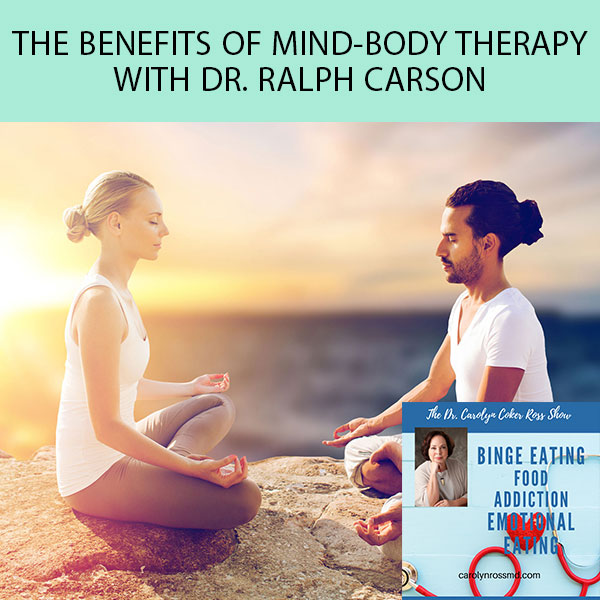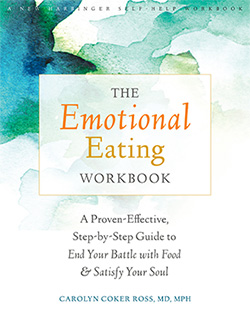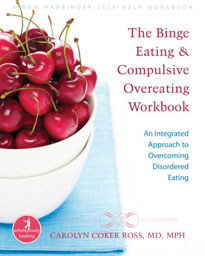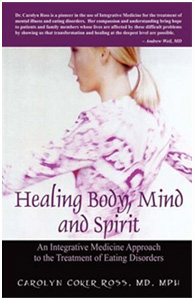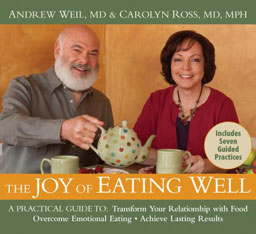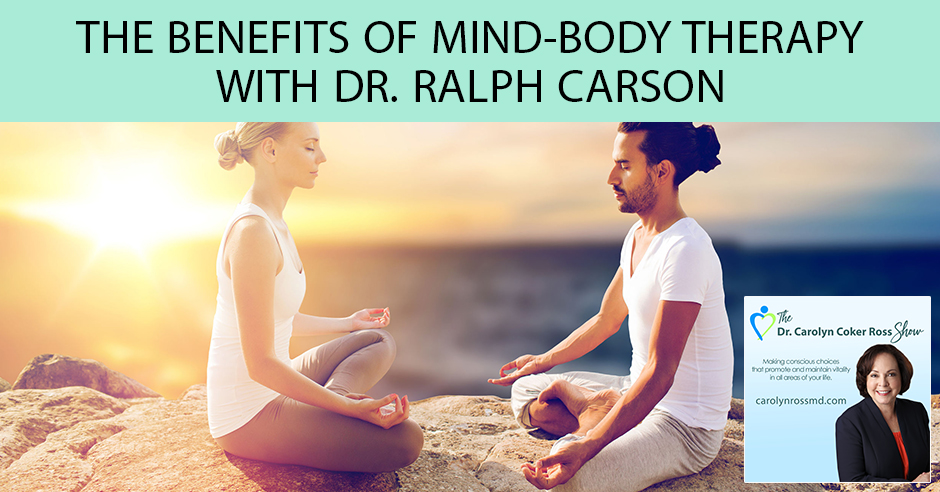
Often overlooked in aiming for a healthy lifestyle is the mind/brain aspect. People tend to be more engrossed in the physical activities and transformation. Dr. Ralph Carson believes otherwise and puts forth the importance of mind-body therapy. He is a clinical nutritionist and exercise physiologist with nearly 40 years of experience in the treatment of addictions, obesity, and eating disorders. He integrates bio physiological intervention and proven psychotherapeutic treatment. Dr. Carson talks about the effect of nutrition on the structure of the brain, breaking down the three components of nutrition. Moving deeper to the brain, he discusses neurotransmitters and how nutrition can reverse brain changes in relation to overcoming addiction and disorders. He likewise gives examples of a mind-body therapy other than nutrition with yoga, meditation, and massage.
—
Listen to the podcast here:
The Benefits Of Mind-Body Therapy with Dr. Ralph Carson
My special guest is Dr. Ralph Carson. Dr. Carson has been involved in the clinical treatment of obesity, addictions and eating disorders for over 30 years. His unique background in health science and medicine coupled with nutrition and exercise has prepared him to integrate bio physiological intervention and proven psychotherapeutic treatment. Dr. Carson has honed his skills in communication and often complicated science into enjoyable, practical and informative workshops. He co-authored the popular book on nutrition and health called Harnessing The Healing Power Of Fruit and The Brain Fix: Healing The Brain During Recovery From Addiction Or Eating Disorders. We’re going to be talking a little bit about your book but the title is Changing The Addict’s ED Default Mode: Yoga, Meditation, and Massage. You talk a lot about mind-body therapies. What do you include in that topic? Mind-body therapies?
My background, being in the field of nutrition and exercise, there are three areas. One is that the psychotherapy component is designed to stimulate the brain in a form that most people would understand is rewiring the brain or we would call it in neuroscience plasticity. The second part is once it’s stimulated to provide for its nurturing. In a sense, it’s the nutrition part and dealing with how nutrition affects this change in the structure of the brain. The last part is when this all happens and that is the component of sleep therapy, which the components of yoga are a big part of that.
You say that nutrition has an effect on the structure of the brain. Can you say a little bit more about that?
I like to break it down in the sense that the brain is similar to when we treat the heart. The brain is the last part of the body to go, it hangs on, that it’s the most important. There are certain components of nutrition that a lot of times people don’t connect with. One of these is the fact that the brain needs energy and its primary energy comes from carbohydrates and the need for good complex carbohydrates. The second factor, which is even more important that is missed when we begin to receive people in recovery is the need for these Omega-3s and to minimize the saturated fats and trans fats because the brain is made up of these. When we talk about even cholesterol, it’s the science that’s totally different than most people understand that the cholesterol that is part of the brain does not come from what is made by the liver.
90% of the cells in the brain are called glial cells and they produce the cholesterol. They improve the synapses. The whole communication of the brain depends on this intricate balance of the types of fats in our diet. It truly is you are what you eat. The last thing is missed and we try to emphasize this nutrition because of these fats, many of them being unsaturated, can be easily oxidized. There’s a lot of oxygen taking place in the brain and the need for fruits and vegetables to provide these valuable antioxidants. Those are the big three components of nutrition.
[bctt tweet=”Nutrition has an effect on the structure of the brain. ” username=”CarolynCRossMD”]One of the things that I want to be clearer about is your second point about fat. You’re saying while many people like cardiologists talk about the need to reduce cholesterol in the diet and reduce cholesterol in the blood. Are you saying that the brain still needs cholesterol in order to function well?
Absolutely and this is where we’re definitely on the same page as we always talk about balance. This concept of cholesterol is bad is not correct, it’s a balance of. There is a lot of data coming out of this harm of having too little cholesterol. When statin started becoming very popular there was some concern what would this effect have if you get the cholesterol too low? You have significant behavioral changes, significant changes in terms of erectile dysfunction. You have changes in terms of cognitive function. They even call it low cholesterol amnesia and even high incidence of suicidal ideation. We’re getting concerned that we don’t take this to extremes. When I work in the field of addiction and eating disorders, you have people who are extremes. They all go from one end to the other and they get to that extreme where they want to get their cholesterol even too low. It’s this balance that we shoot for all the time.
Does that explain some of the studies that we’re seeing on using Omega-3 fatty acids to reduce suicidal ideation? I know there was a study published in the American Journal of Psychiatry that showed that higher levels of Omega-3 fatty acids were associated with decreased risk for suicide attempts.
It’s interesting the way I try to visualize or help people to understand is that most of the major communications that will occur in the brain are by neurotransmitters. This is complex. I like to think of those as pitching machines like you’re pitching a baseball. You’re pitching it to a catcher, which is a receptor and it’s only when it’s caught that you get a response. These receptors have to be flexible to be able to go out and catch that ball but it doesn’t come exactly to them. That ability to be flexible is dependent on the fluidity you get from the Omega-3s. If you start getting too much trans fats or saturated fats, these receptors become fixed and you get a poor response to the neuroreceptors. A lot of times the way we attack this from a pharmacologic standpoint, “Let’s go ahead and make more of the neurotransmitter. Let’s pitch more baseballs,” but you can get a better balance if you look at also trying to improve the receptors. That’s where these Omega-3s come in. They improve the ability for the cells to catch the receptor. Therefore, by having better connections then you’re going to have better responses, mood stabilization and all the things that lead to the prevention of suicide.
They tend to increase the effectiveness of the serotonin drugs like Prozac and those using Omega-3s it seems.

Mind-Body Therapy: The brain still needs cholesterol in order to function well.
I’m getting some feedback from some people who are certainly practitioners in the field. The physician certainly needs to be aware that the patient is on a regiment of Omega-3s because they may need to adjust that particular medication because they become more effective.
You don’t have to take as much and you don’t have to get into the side effects of those drugs of the prescription antidepressants if you’re on Omega-3s. The clients we’re talking about people with a history of trauma addictions, eating disorders and a history of sexual abuse. There are a lot of dysfunctional parts of the brain and part of that is from nutrition. There are also other changes in the brain that we can see on MRI. I know in anorexia there have been some studies. Are there things that you can say about what effect addictions and eating disorders have on our brain?
Let me hit on some of them. It’s nice we have all these different types of brain scans. I know in the earlier years when we first started, all we had were what they called the PET scans and the MRIs which are taking a snapshot picture of the brain or perhaps a moving picture. Now, we have ways to see the communication between cells. We can also see if there’s an increase or decrease of the actual tissue, which we call grey or white matter. We do see in the interactive population that this process of starvation causes loss of brain tissue. If they do nothing else but receive the patient correctly that we have this regeneration of nerve tissue so it increases. The issue is we need to have this integrated approach so we make sure that we’re increasing the grey matter and not just the white matter or vice versa.
That’s a plus and that’s also seen in many of the addictive states. The cocaine use and heroin use, we’re seeing an increase. They call them a Rolex-type of the image that we see an increase in the different matter of the tissues. There are so many areas and it’s still a new science. The areas that have been focused on the most in terms of increase in activity would be what we call the prefrontal cortex. This simply is the executive function. It’s the ability to think clearly and to make decisions and not be impulsive and to have learning and memory. We see increases in the cell structure of that area. We see increases in the area of memory, which is called the hippocampus. We’re going to be having problems in the near future with a number of people who will be struggling with dementia and Alzheimer’s disease.
How does nutrition reverse these brain changes? Can it?
[bctt tweet=”You are what you eat.” username=”CarolynCRossMD”]It goes one in one. When we take and stimulate cell growth, then you need these prerequisites. The energy in the brain is going to be a key prerequisite of self-healing and it needs a lot of energy. For example, we know a lot of people especially in the addiction field who go into treatment. They want to change their lives and they’ll begin to go on these diets that are very low carbohydrate. That is detrimental to a brain that’s healing that particularly prefers to use pure glucose. There needs to be a continuous representation of glucose in the brain at all times. The brain heals pretty much in these stages of sleep we call restorative sleep, which is stage three and four. That’s when the brain heals. We know this in terms of the body because it puts out something called growth hormone but it’s also a part of the brain. These areas get larger the longer we’re asleep or as we get towards the morning awakening. Perhaps the hours of 3:00, 4:00 or 5:00 in the morning is when you need to have carbohydrates available to make the brain able to heal. If people have exhausted their store of carbohydrate, which is the liver and they have not eaten since 6:00 or 7:00, there is not a whole lot of energy for healing to take place. This designing of food plan that provides energy all the time is extremely important.
We’re talking a lot about nutrition and how it helps to heal the brain. Can you mention a little bit about how this affects our patients who are struggling with obesity, whether they have binge-eating disorder or just obesity for other reasons? How being on the diet treadmill and some of the diets that are popular might have an effect on the brain?
As you begin to view these patients as a combination of behavioral as well as nutrition, they do have different brains. This is the interesting thing that people beat themselves up because they have trouble controlling the intake of food. When we look into the brains with these scans, we’ll find that many of them, I hate to use this but it’s exactly the same thing, there are similarities in the obese population particularly ones that cannot control their intake with people who are addicts. The key area that has loomed big in terms of when we look at the brain is an area that we would call the reward center, the motivational center. What drives us? What gives us the urge, the cravings? This would be an area that’s called the nucleus accumbens and it works primarily on this reward hormone called dopamine. What has evolved over twenty or so years is that when we look at these areas on people who are obese, there are fewer receptors. The term that’s used is a reward deficiency syndrome. What happens is that they need more dopamine to get that excitement, to get that feel-good feeling.
We see that with addicts after they get sober. That they often don’t get rewards or get that feel-good feeling from the same things that other people do.
There’s a cross-sensitization or people call it cross addiction or a dry drunk because there is no change in their brain if they haven’t gotten this area in balance. As people get this urge, the types of things that they crave is an interesting observation. It’s not necessarily people want to think it’s sugar or it’s a particular chemistry but it has to do more with the sensory input. We’ve learned that the types of foods that people crave are food that goes under the heading of contrast effect and that’s a simple concept. It means that food quickly changes their form. For example, if you can have food that quickly goes from a solid to a liquid to a gas, simulating the texture and the mouthfeel as well as the taste and smell, then you’ve got incredible input that indirectly goes in this rewarding area. If you say, “What are the foods we crave?” You wouldn’t say we crave table sugar, but it would be chocolate, Oreo cookies, French fries, pizza or chips. You’ll see that those foods quickly go through this whole series of sensory input. We call them contrast food.

Mind-Body Therapy: People beat themselves up because they have trouble controlling the intake of food.
A lot of people do say they crave sweets or they crave salty foods. All of these foods that you’re listing here have that contrast effect. It’s not just sweets or the salty but some of the studies do show that sugary foods have an effect on the dopamine reward center.
I want to follow that through that we’re finding that definitely in the studies on rodents or rats but it’s not as clear when we begin to take this as humans. When we begin to break it down in terms of tolerance and withdrawal, it becomes cloudy. To continue the resources, we might find that and it’s going to be a certain percent of the makeup. When you look at the concept of sweetness and you look at this area of the brain, there are two key things that we have to look at. Number one is why is the brain designed this way? We’re looking at this from a survival our Paleolithic concept. It’s believed that this reward is necessary to make us seek out food.
To risk the danger in the Paleolithic times that we had to risk getting to the food.
When you think about sweetness and what that does for the brain, there are two things. One is it means it’s safe. If we take in something that’s not sweet and we’re not knowledgeable, then it could be poisonous and cause problems. As soon as the sweet taste buds are all lining the tip of the tongue, the outside portion, that’s the first to get the cue that, “This is safe to eat.” The second thing is they’re beginning to do studies and it recently came out that they’re looking at the endocannabinoid system. Most people would know this if they know about marijuana. Marijuana causes people to have munchies and what stimulates this particular reward response is fat. In Paleolithic times, as people came across food that was fat, it meant, “Store it up because you don’t know when you’ll eat again.” You get this endocannabinoid response to the brain that says, “Eat up. Eat lots of it.” You have this combination of cravings for fat specifically in the endocannabinoid system and then you have this craving for sugar that can happen more in the sense of the opioids. Those are things that are the anticipation of food. You put them together and we find that human beings are designed not to necessarily crave pure sweet. We’re not necessarily designed to crave pure fat but almost a combination of the two.
Most sweets come along with fats so that works fine.
[bctt tweet=”The brain heals pretty much in the stages of sleep.” username=”CarolynCRossMD”]If you look at the fast food industry, they have done a great job of figuring this out. In other words, I call the food industry almost like the sex industry. You take out all the bad parts and you just leave the good parts.
I don’t know if the food industry would be happy being compared with the sex industry but there’s definitely a similarity.
We take out the fiber. We take out the things that don’t taste good and we just leave the fat and sugar behind.
You say in the intro to the book, “Body-mind therapies can be very effective at addressing early trauma and sexual abuse as well as addiction and eating disorder behavior.” How do these types of mind-body therapies help about the things we’re talking about like cravings and behaviors of addiction, overeating and so on?
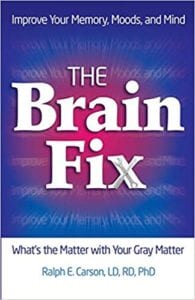
The Brain Fix: What’s the Matter with Your Gray Matter: Improve Your Memory, Moods, and Mind
What we begin to do in our thought process is let’s take the spirituality component and we look at the brain is going to change. The unfortunate thing is that from doing things over and over again or that perhaps we’re wired a certain way. Just because we make up our minds we say, “I’m going to change. I’m not going to eat this food. I’m not going to behave this way,” the brain doesn’t change no differently than your computer will change. I like to use this analogy. Let’s say we go to our computer and we are going to write a letter. We’d like to write it in a font that’s Arial and we want to write it in a size that’s ten. We start writing and it comes up Times New Roman font and it comes up size twelve. We go to the computer and we change that and then we write our letter. We come back to the computer. We hope that we can write that letter again in Arial ten and it keeps coming up Times New Roman twelve. That’s what happens in these particular populations.
You’re saying that brain change lags behind our motivation?
It has to be a period where you get the information and it has to be authentic. You have to believe that information is true. It’s not going to be like, “You said so. I’ll change my brain.” You have to believe that information is authentic. You connect with it. It’s genuine. When that brain changes, it is during certain periods. We see that it changes or the plasticity changes during certain periods of sleep. It particularly changes when you get into wave patterns that we call gamma wave patterns.
Tell me a little bit more about the gamma wave patterns.
I’m simplifying this but I like to think of it as we have a conscious state where we’re aware and that’s where we’re aware of everything. That’s when our mind ruminates. We think about a problem and we go in all different directions. We have a state where we’re unconscious. We are not aware that we’re thinking. Somewhere between that conscious and unconscious state is a state where we’re aware. We’re not challenging. We’re not analyzing. We’re not interpreting. We’re just listening to ourselves think.
It’s like an observer state?
[bctt tweet=”The types of foods that people crave are foods that go under the heading of contrast effect.” username=”CarolynCRossMD”]It’s all about thoughtless awareness. That’s how they sometimes term it. It is during this phase that you would see the gamma waves. A lot of times you’ll hear people refer to this when we talk about meditation or yoga. You’ll hear them talk about this as a state that is in synchrony, in harmony. Everything is right. When you get a gamma wave, it’s synchronous. It’s the same amplitude or height and it’s the same rhythm. It’s this particular state where you listen to yourself think that the brain rewires itself, but it sets that default mode to it’s always going to be Arial ten. We begin to change our thought processes.
That’s why sleep is important, especially for weight loss too but also you’re saying for behaviors.
The person has to if they’re going to change these bad habits and it’s going to be changing their brain so they’re developing new pathways. They have to have this information, which they want to change. That they agree on what is valuable in their change and then when they sleep, this whole brain begins to rewire itself. It becomes something that is part of them as opposed to something they have to white knuckle and do moment to moment. It has more permanency.
Is there any information about how long it takes for these changes to happen? I know in preventive medicine we say it’s three to five years to make a behavior change. Can you give us a number?
I’m afraid that what they’re looking at so far in terms of these permanent changes is, at least in the addicts, it’s two years.

Mind-Body Therapy: Compassion is happiness.
Dr. Carson is employed and on the Speakers Bureau at Remuda Ranch Eating Disorder and Anxiety Treatment Center, which is in Arizona. He has a book called The Brain Fix: Healing The Brain During Recovery From Addiction Or Eating Disorder. When is it due to being released?
I’ve written the first draft and it’s being edited. I’m suspecting that it’ll be available in November, December.
We were talking a little bit about making permanent changes and you said that some of the research shows that to make a permanent change with the addicts, it’s about two years. Many of them don’t make it to two years. Is there any evidence to support the use of mind-body therapies, nutrition and speeding up that timeframe at all?
You are well-aware of in research, it’s always difficult because are many compounds in this whole process. Is it due to nutrition? Is it due to the particular program they went through? How many times have they gone through recovery before? What’s going to happen is we’re going to have a great deal of better input if we can get more numbers in terms of looking at the brain changes. I would love to see a time where someone goes into treatment and we take a picture of particular areas that we know change and then have someone go through the whole process without doing any of the things we’re suggesting and have other people go through with this integrated approach. We’ll see definite changes but we’re not at that stage yet.
I do know that a big problem we have with helping people in terms of recovery is to make them connect with their program. What I’m finding as I work so much with patients all around the country is that it’s such a window for people to get it so that they enter into being committed to their recovery once they can see it. Some of the terminologies I use is I always use focus. What is a feeling? How do you know someone’s happy? What is needed in the field of neuroscience is we can look at what happiness looks like. A great example of this is people will say, “Happy is a smile.” It’s neat and looking at the data on a smile there is a type of smile that’s called the Duchenne smile. This is an authentic smile.
[bctt tweet=”Human beings are designed not to necessarily crave pure sweet nor pure fat, rather almost a combination of the two. ” username=”CarolynCRossMD”]There’s a contrast they call the Pan Am smile. The Pan Am smile is like the old stewardesses on the planes that would always smile as you get off. It was a fake smile. You sometimes can’t tell by appearance. For example, they look at the left prefrontal cortex which many of the researchers on meditation look at joy and happiness. If you looked at what may be a high school student that’s into themselves might say, “I would be happy if I had a lot of money,” but nothing lights up if they’re given lots of things in their left prefrontal cortex. What’s working is the primitive part of the brain where dopamine is being put out in the limbic system or emotional center. However, if you look at people who really experienced compassion, then they’re left prefrontal cortex lights up. Compassion is happiness, money is not.
That destroys a lot of my preconceived notions then. We’ve been talking a lot about nutrition and I don’t want to miss talking about some of the other body-mind therapies. I have one last question about nutrition. I know Kenneth Blum has done quite a bit of research in the use of amino acids to impact the brain. What are your thoughts about that?
I’ve seen a lot of Dr. Blum’s work. I’m looking forward to doing some research with him on some genetic studies and looking at the different amino acids in the work that he does. I’m impressed to follow this along in terms of having precursors as certain things that make these neurotransmitters affect the balance. It’s balance. This concept of amino acids has to do with not just one particular mega doses but looking at the whole array and making sure that there’s this balance of all these neurotransmitters.
He uses it for treatment of addictions and there’s also been some application in other areas. Let’s move on to talking a little bit about the effects of yoga on recovery and Tai Chi on recovery from eating disorders and addictions. What does the research say about that?
What I like to do is unique because I’m coming from this scientific background that is a little bit different than the background of people who necessarily come from the Far East and practice it. If you break it down and it’s a great model for body, mind and spirit, you break down into the body where you’re dealing with these postures. It helps a person to begin to be mindful of their body in a sense that people who have a real problem with their self-image can relate to. It’s letting go of what society says and begin to get in tune with their body.

Mind-Body Therapy: It’s incredible how people can help themselves with chronic pain due to the elements of yoga.
You’re here talking about the yoga postures also called Asanas.
That and maybe even make correlations in terms of you will have the anorectic who is rigid and restricted posture. That in doing these other postures, say they have a posture called the cobra you could picture a snake opening up. It allows them to feel what it’s like to let go and at that moment where it’s nonjudgmental. The other thing is that a lot of recoveries have to do with this concept of having energy. When we find that people internalize stress, then they’re going to have musculoskeletal contractions and they get tight. When you begin to feel your body and loosen up, it’s that loosening up and carrying around that looseness with you that gives you energy and reenergizes the body. If people have pain, it’s emotional pain as well as physical pain. When we use some of this terminology in terms of, “Let it go,” they can sense that difference at that moment what letting it go feels like.
I know there’s some research that shows also that yoga not only helps with depression and anxiety but also for obese patients it can help with glucose intolerance and insulin sensitivity. It might help you lose weight. Are there other health effects of yoga that are applicable to addictions and eating disorders?
I know that specifically, in terms of eating, you’re feeling yourself and you put in the context of, “I feel myself getting more flexible and looser.” They also get a sense of getting a feeling of what emotional hunger is versus eating because I’m physically hungry. There becomes that entombment and the mindfulness there that is helpful. We talk in terms of this idea of life force. I know that people hear the terminology meridians, chakras and chi. I have a little difficulty presenting it in terms of the scientific community because these things are hard to measure or to be able to document. I like to think of it as the breath, meaning that getting oxygen to the tissues and exchanging it. As you learn how the breath gives you energy, it helps you to let go of things also. That’s powerful in terms of recovery.
This life force also is neat because we’re talking about trauma. You talk about controlling this emergency system fight, flight or freeze. There’s psychic numbing so no information is going to get through because as soon as you say something that’s traumatic, I shut off my brain. You begin to have an avenue where people can learn to let go and take in information. That breathing and concentrating on the breathing helps to be a tool that they can connect with that moment that they can enter into listening to information and accepting it. I’d like to think that when people are nervous that as soon as they breathe, their stomach goes in when they inhale. That’s totally opposite of what their brain needs because when the stomach goes in then they are pushing your diaphragm up, you can’t take in oxygen. What you want to do is the reverse. Have your stomach go out and have your diaphragm go down, so you can take in oxygen and you can get a good exchange of oxygen. It calms the vagus nerve. The vagus nerve is key in terms of the parasympathetic nervous system. That means the rest and the calmness that puts it at ease.
[bctt tweet=”We are not aware that we’re thinking somewhere between the conscious and unconscious state. ” username=”CarolynCRossMD”]You have this really nice connection instead of saying words, “Relax.” What does relax mean? You show them what it feels in terms of breathing. They can begin to make this connection and they can immediately calm down. We use this lot with athletes. As you can imagine an athlete, let’s say a golfer. A golfer is on the golf course. They do well playing with a bunch of friends but now they’re going to be professional. They’re going to be, “This putt is worth many thousands of dollars.” The people are watching them. They can dissociate themselves from that stressful moment by focusing on breathing and the breath and it calms them down. It makes them focus. If they can improve in sports, we can get people to de-stress themselves at the moment, which they need to do quite frequently in life.
There are other health benefits of yoga too in terms of cancer and some other diseases.
Pretty much anything you can mention. If you go over the long list of risk factors, things like blood pressure, heart rate, cholesterol levels change, something we call insulin resistance, which is helping people control their blood sugar. You have this area which is complicated but it’s interesting when we talk about heart rate variability. There’s a change in the rhythm of the heart as you get excited and don’t get excited. This is an indication of how well your heart is functioning and those changes as a result of yoga. You also see it’s improved sleep. Here we are trying to get people to get more sleep, better sleep, quality sleep. Yoga significantly helps in terms of reducing insomnia. In the addictions world, we have many people who struggle with pain and get on pain medication. That’s almost the number one addictive substance there is now is prescription medications. It’s incredible how people can help themselves with chronic pain through the elements of yoga. Breast cancer, longevity probably isn’t something that you can’t relate to the benefits that you could get from reducing stress and reducing inflammation with regards to yoga.
We’ve talked about some of the mind-body therapies such as yoga. What about some of the touch therapies like acupuncture and massage? What are the benefits that you see for addictions and eating disorders, if there are any benefits set for treating trauma?

Mind-Body Therapy: Harnessing The Healing Power Of Fruit: The New Paradigm for Optimum Health
As we begin to research this and start looking at as a peripheral science where we get down to it, one of the most fascinating things that opened my eyes to touch is that if you injure your hand, instinctively what you do immediately is you touch it with the other hand. We are innate in terms of the need to touch even if it’s self-touch in order to reduce pain, to get soothing and self-soothing and so forth. When we look at other people touching, it’s an actual skilled profession in terms of helping people to get feel comfortable with touch. The need of touch is important. The needs of other people are important. A neat study is where people were given an irritation or a blister on their heel and it caused pain. The level of pain which was measured as muscle contraction reduced when the women touched her husband’s hand.
Intuitively it makes a lot of sense. The problem is proving it in science. We’re talking about touch therapies. Is there any research to support massage and acupuncture in treating addictions and eating disorders? I know a little bit about those, but I wondered besides things like treating depression, does it have a direct effect on recovery?
There are. It’s starting to be. Even dating back to the late ‘90s and the early turn of the century that there have been significant studies of bulimia. They do these studies where they have scores or psychometric measurements where they’re in pencil and paper, but they’re called Eating Disorder Inventory scores. When massage therapy was used, in just five weeks there was a significant reduction in those scores. The nice thing is now we can measure certain outputs by microdialysis of certain chemicals like endorphins and we see that there is a significant increase of endorphins which are the body’s painkillers. For bulimia, anorexia nervosa and binge-eating disorder, there are some preliminary studies that are encouraging. When they’re encouraged, that means others will take up the job of continuing those studies. The problem is the long-term studies which we always want to have and the longest that I have I’m aware of is a year.
Some of the studies on medications, bulimia and anorexia are shorter than that. What about acupuncture?
I understand acupuncture and I’m all for it. The one study it’s always referred to, in fact there were two of the same thing, they gave people a pain medication, then they gave them acupuncture and giving them something called sham acupuncture where you just placed needles, nothing accurate about it. They looked at the differences in pain and they found that the ones that had the most improvement were the sham acupuncture. The second was the acupuncture and the third with the medication. We’ve got a lot more to do in that area to be able to confirm what changes are happening. There are a lot of good studies out there but that’s the one that I’ve always heard and everybody wants to relate to is the sham acupuncture.
The acupuncturists will say that sham acupuncture is impossible. If you’re putting needles in the body, you are changing the energy flow in the body.
[bctt tweet=”When people internalize stress, they’re going to have musculoskeletal contractions and get very tight. ” username=”CarolynCRossMD”]That’s probably what the findings will be because it’s interesting to look at those studies and they were conducted fairly well.
There are good studies but as an integrative medicine physician, I know that’s an issue that always comes up in research, even on herbs. When we look at some of the research on herbs and vitamins, it can be difficult to sort out the results. I wanted to also ask you if there’s any research on the effects of body-mind therapies on preventing relapse.
We are pretty much going out and following people up for the longest I’ve seen and some of these things are for a year. They’re doing some pretty good long-term studies in what they’ll call mindfulness as far as eating behaviors and mindfulness type of therapies.
I know that there are some studies on Vipassana meditation and reducing relapse in alcoholics who were incarcerated. There are a couple that I’ve seen that show that meditation might help even after you are sober and to help prevent relapse. All of that’s encouraging.
Since you hit on the treatments with the amino acids, there are two or three good studies in terms of using amino acids in relapse with addictions too.
Is it oral amino acids or the intravenous ones?
Those were done in the intravenous that I’m familiar with anyway.
Using intravenous amino acids such as things like tyrosine, tryptophan, for people who don’t know what the amino acids are that we’re using.
The easy way for them to understand a little bit is that these chemicals that communicate from cell to cell called neurotransmitters are called monoamines. A monoamine is a single amino acid and amino acid makes up a protein. Just like letters make up words, amino acids make up proteins.
When you eat something like chicken or turkey when it comes into the body, it is broken down into amino acids such as tryptophan, phenylalanine and all of those. Using these amino acids intravenously, there are some centers that are using it to help people detox from drugs and then continuing to use it to help prevent relapse. I wanted to ask you, is there a favorite breathing exercise that you have that we could teach our audience?
One that I like is what I call abdominal breathing. What you will do is get into a relaxed position wherever you are. You’d be best if you were sitting in a chair and it’s somewhat quiet. What you’re going to do is you’re going to place the tips of your middle fingers together over your navel or your belly button. The tips of your middle fingers are barely touching. What you’re going to do is you’re going to take and breathe in. You’re going to breathe in so as you breathe in, the stomach will go out and your fingers will separate. What we’ll do is we’ll breathe in on the count of four very slowly. Breathe in one, two, three, four and hold it. We’re going to exhale and we’re going to do this exhalation through our nose and the fingers will come back together. We’re going to breathe in until we can’t do anymore but we’re not going to do it forcibly. We’re going to do that for probably 60 seconds and everybody relaxes. If you took your pulse and measured it and you took it after a minute, you would see that it goes down. It’s a neat little thing to calm you down immediately. I’ll talk people through it. The first thing is to get comfortable, your eyes are closed and then put in place your fingers together over your navel and slowly breathe in. Your fingers will separate one, two, three and four. Hold it and exhale through your nose. The stomach goes in. Fingers come together. Inhale. Stomach out. Hold. Exhale. Stomach in.
That’s a wonderful exercise. I know that the trick to breathing exercises having any benefit is to practice it. I hope that our audience will get a chance to do that. I’d like to thank our guest, Dr. Ralph Carson, for being on the show and talking to us about healing the brain from addictions and eating disorders and about mind-body therapies. Next episode, my guest will be Isabelle Tierney. She’s a psychotherapist and she will be talking with us about emotional eating and soulful eating. Until then, I wish you good health and vitality.
Important Links:
- Dr. Ralph Carson
- Harnessing The Healing Power Of Fruit
- The Brain Fix: Healing The Brain During Recovery From Addiction Or Eating Disorders
About Dr. Ralph Carson LD, RD, PhD
 Dr. Ralph Carson is a clinical nutritionist and exercise physiologist with nearly 40 years of experience in the treatment of addictions, obesity and eating disorders.
Dr. Ralph Carson is a clinical nutritionist and exercise physiologist with nearly 40 years of experience in the treatment of addictions, obesity and eating disorders.
Prior to joining ERC, Dr. Carson was the Executive Director of FitRx in Brentwood, Tennessee, an outpatient program for people of size struggling with both medical and psychological complications of binge eating. He was also a clinical consultant to PineGrove Behavioral Health and Addiction Treatment Center in Hattiesburg, Mississippi, as well as other eating disorder treatment centers across the country. In addition to his successful clinical practice, Dr. Carson is committed to community education and teaching the next generation of healthcare professionals specializing in exercise therapy, sports nutrition, eating disorders and obesity. He has been a faculty member of the University of Alabama at Huntsville for over 20 years, is a nutritional advisor to numerous university athletic departments, including the University of Tennessee National Basketball Champion Lady Volunteers, and speaks regularly to professional and lay audiences alike. Dr. Carson is the author of Harnessing the Healing Power of Fruit and The Brain Fix: What’s the Matter with Your Gray Matter, and has published more than 20 articles.
Additionally, Dr. Carson is an active board member of the International Association of Eating Disorder Professionals (IAEDP) and the Binge Eating Disorder Association (BEDA). He has earned multiple degrees, including a Bachelor of Science from Duke University; Bachelor of Health Science from Duke University Medical School; Bachelor of Science in Nutrition from Oakwood College; and a Ph.D. in Nutrition from Auburn University.

